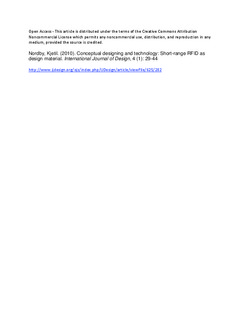| dc.description.abstract | Industrial and interaction designers are increasingly faced with new computational technologies that may be used as materials in designing. Such materials are important in design practices because they offer conditions for conceptualisation and production of new designs. However, new computational technologies are often very complex and not presented with the intention of supporting design practices.
This study explores such a problem by way of a study of Short-Range RFID (SR-RFID) as design material. SR-RFID is a new computational technology that enables a transaction of information between a radio transmitter and an RFID tag when the two are within a very short range (2-5 cm). As a design material, SR-RFID crosses the traditional boundaries between industrial and interaction design by offering temporal and spatial properties that may be shaped by both disciplines.
In investigating SR-RFID as a design material, we are faced with two important challenges. First, the available information concerning SR-RFID in relation to industrial and interaction design is limited and often oriented toward finished solutions rather than exposing potentials for designing. Second, it is difficult to find frameworks that show how to analyse such a technology so as to present it as a material specifically oriented toward industrial and interaction design.
I meet this challenge by applying a process of research by design. In this process, a series of explorative design probes has been carried out with the purpose of exposing design-related properties of SR-RFID. The design research has been conducted by a multidisciplinary team of researchers and designers as part of a larger research project called Touch.
Central to my study is the use of activity theory in building a conceptual framework that allows the analysis of computational technology as design material. This framework has been applied to SR-RFID in order to re-conceptualise it for designing.
The study has found that in order to understand SR-RFID in relation to industrial and interaction design it is useful to reinterpret it as a design material. I offer three main reflections on SR-RFID as design material. First, I argue that SR-RFID may be seen as near-field material. This material is specifically oriented toward industrial and interaction designers' form-making. Second, I present how SR-RFID may be seen as a conceptual material that helps us focus on material properties that have special significance in the creation of forms. Third, I argue that when creating design materials for industrial and interaction design, we should pay particular attention to the concept of motive. Motives may help us understand what SR-RFID means in designers' activity.
The results of this study offer one example of how activity theory could be used in interaction and industrial design research to understand materials. Furthermore, it expands upon current research that investigates computational technology as materials. In addition, new insights into the makeup of SR-RFID are offered that may be further appropriated and used in design and design teaching. | no_NO |



